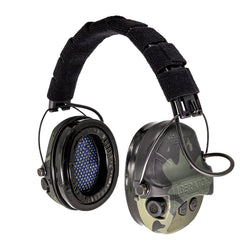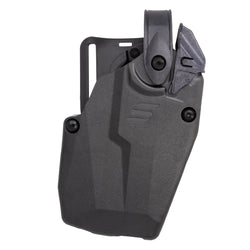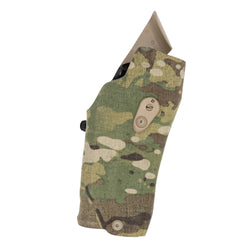The Vortex Defender line of micro-optics has been a huge success in my opinion. They started with the CCW, an optic for compact pistols, and then moved to the ST and XL. This gives gun owners three sizes to choose from. I’ve used all three of these optics and have never had any issues with them.
Well, now, Vortex is building on the Defender line with enclosed emitter optics, the CCW Enclosed Solar and the ST Enclosed Solar micro red dots. We covered the ST Solar in another article, so be sure to check that one out.
The first micro enclosed emitter optic from Vortex was the recent Viper Shotgun Enclosed Micro Red Dot. That optic has a special base made just for mounting to shotguns, and as it turns out, it is also perfect for lever-action guns as well. After spending some time with that optic, I couldn’t wait for Vortex to release a micro-enclosed version for handguns.
With these two newest releases, Vortex appears to be following the same family of sizes as they did with the open emitter optics. Small (CCW), standard (ST), and extra large (XL). This truly provides a complete set of handgun optics for just about anyone. The fact that it’s Vortex making these is a huge plus for me. I’ll give my two cents about Vortex and why I like the company so much at the end of this article.
But for now, let’s jump right into this brand-new optic, the Enclosed Defender CCW Solar.
Defender CCW Enclosed Solar Micro Red Dot
I wasn’t surprised to see the enclosed CCW hit the market. In fact, I was kind of expecting it after seeing the Viper Shotgun optic that was released earlier this year. But what I didn’t expect to see was a built-in solar capability. This will drastically increase the run-time of the optic.
Let’s cover the basics of the new CCW Enclosed first, and then get more into how the solar part works.
Quick overview
The CCW Enclosed Solar uses the Shield RMS footprint, which is also the same mounting hole pattern as the RMSc footprint. It will work on any gun the original Defender CCW works with. Overall, it is 1.6 inches long, 1.2 inches wide, and 1.1 inches tall. Right now, it is available as a red dot, but it makes sense that a green dot will soon follow.

It has unlimited eye relief and is parallax-free. Windage and elevation adjustments are 1 MOA per click. Vortex provides a sight tool that can be used to zero the optic and change the battery.
Control buttons are located on the left side, and the battery loads on the right. Vortex kept the same aggressive texturing on the front of the optic, just like the original CCW Defender. This texturing, which they call “Fast-Rack,” is useful when using the optic to rack the slide on your gun.
Motion activation
Motion activation is the same as the others in the Defender line. The optic will turn off after 10 minutes when there is no motion. You can turn this feature on by holding both buttons for three seconds, and the same to turn it back off. I like to keep this feature turned on so I don’t have to worry about turning my optic off at the end of each day.
Optic controls
The controls are about the same as the original Defender line. Press any button to wake the optic up and adjust the dot with the up and down buttons. Hold the down button to turn the optic off and press the up button for three seconds to lock the settings in place.
Pushing both buttons at the same time? Well that is a new feature for the Defender line that provides multiple reticles.

You wouldn’t think it would really matter where the buttons were located, but over time, I’ve seen them on top, on the right, left, and back. Having larger buttons on the right side is my favorite location for handgun optics.
Multiple reticle options
Being able to select the reticle you like is a great option to have. The Vortex Defender CCW Solar has a 3 MOA dot only, a 32 MOA circle only, or a circle and dot option. Just press both buttons at the same time to cycle through them.
For self-defense applications, I’ve found the circle-only works best for me. It’s easy for my eyes to pick up quickly when bringing the gun up to my line of sight. Just select the reticle and brightness setting you prefer and lock the setting in place.
Solar Power and Battery
A CR2032 battery powers the Defender CCW Enclosed Solar, which provides about 32,000 hours of run time. But with the addition of a solar panel on top of the optic, the run time is estimated to be a whopping 150,000 hours.

There has been some debate on whether or not built-in solar is reliable on an optic. Because the CCW Solar optic runs on a standard battery, it will work with or without the built-in solar function. This means if it gets broken in the field, you won’t even notice. And if it does get broken, Vortex will take care of it. For me, this is a win-win, and there aren’t really any drawbacks.
When it comes to loading the battery, I did find one little thing that I’m on the fence about. The battery cap is deep enough for the battery to fully sit in the cap. This is good because when you take the cap off, the battery is in it and doesn’t fall out. But it did take me a minute to get the battery to come out of the cap. It’s such a precise fit that it causes a little bit of suction when trying to get the battery to fall out. I ended up using my fingernail and slowly pulling the battery out.

Again, this isn’t a huge issue because you don’t have to change batteries in it that often. Especially with the solar function that extends the battery life. It’s just something to be aware of when changing the battery.
Testing and evaluating the Defender CCW Enclosed Solar Red Dot
I’ve tested a lot of Vortex optics over the years, and so far, I have never had any issues with them. This includes freezing them, heating them up in the oven, throwing them in the dryer and buckets of water, etc. With an enclosed red dot, I was even more confident this one would hold up as well. But with any new optic, I like to put it through the ringer.
Trial by fire
The first test I did with the Defender CCW Enclosed Solar was to throw it in the dryer. I’ve found this to be a good way to test it with heat and impact. It’s surprising how loud a small metal object is when it’s bouncing around in the dryer by itself. I let this one run a full cycle on high heat. Maybe it’s because this optic is a little heavier than an open emitter optic, but it was much louder, so I was starting to think the glass would be broken in it. After getting it out, however, everything seemed to be intact and functioning like it should.
Next, I dropped the Defender CCW Solar in a bucket of water and left it for about two hours. I just want to make sure that if the optic gets wet or dropped in water, it won’t mess it up. Soaking for two hours is probably a little overkill, but hey, that’s ok.

Freezing the optic helps test its capability in cold weather, but it also serves as another water test. You see, I don’t just freeze it; I freeze it in an ice cube. If any water did get in, it would expand when frozen. I left the optic in a glass of water in the freezer overnight. After thawing, it still appeared to be working just fine.
The last test I did was to place the optic in the oven at 250 degrees for several hours. I live in a place where it gets hot in the summer, and a car can climb up to 200 degrees. As expected, there were no issues with the optic when I took it out.
On the range
After doing some tests at home with the CCW Defender Solar Enclosed Red Dot, I headed to the range for the fun part. Blasting through ammo is always fun, right? Well, thanks to AmmoToGo.com, I was able to put 500 rounds of 9mm Blazer 115 gr FMJ ammo down range. I mounted the Defender CCW on my Taurus GX4 Carry, which I think is a superb gun for the price.
As I mentioned before, I like the circle-only reticle the most. It made it easy to see when moving the sight quickly over a target. Sighting it in at 25 yards only took a few minutes, but the big test was to see if it stayed that way. I’ve used some optics that tend to move just a little after a few hundred rounds.

Except for my “oops” moments when I sent a random flyer into the outfield of my target, it did great. By the time I reached the 500th bullet, the optic was still sighted in and holding good groups, just like it did in the beginning.
With the buttons on the left side, it was easy to adjust the brightness quickly without changing my grip on the gun. This isn’t something people often think about, but it’s nice to be able to do it quickly and get back on target.
My two cents about Vortex
There are several reasons why I like Vortex products so much. First, the product is made exceptionally well but not overpriced. Most of us live on a budget and can’t afford to buy optics that come with golden price tags. Especially when you need multiple optics for different guns.
Second, Vortex offers one of the best warranties I’ve ever seen, period. Not just in the gun industry, but anywhere. If you own a Vortex product and it stops working, you accidentally damage it, or anything in between, they will make it right. You don’t have to be the original owner, have the receipt, or prove when it was purchased. If it carries the Vortex name, they will take care of it.
Third, I’ve been to the Vortex facility multiple times and met everyone from the top execs to the warehouse workers. Everyone there is knowledgeable about their job, has a great attitude, and is passionate about what they do. Vortex is 100% employee-owned owned so every employee is invested in making sure the product is top-notch and the customer is happy.
Questions and Answers
What is the main difference between the new Defender CCW Enclosed Solar and the original Defender CCW? The main difference is that the new optic has a completely enclosed design, which protects the emitter from dirt, debris, and moisture. It also features a built-in solar panel to significantly extend the battery life, something the original Defender CCW does not have.
What is the benefit of the new multiple reticle options? The multiple reticle options—a 3 MOA dot, a 32 MOA circle, or a combination of both—allow the user to choose the reticle they prefer or find most effective for a specific shooting application. This customization can help with faster target acquisition.
How does the built-in solar panel affect the optic’s battery life? The solar panel drastically increases the optic’s run time. The standard CR2032 battery provides about 32,000 hours of use, but with the added solar function, the estimated battery life jumps to a remarkable 150,000 hours.
Q: Does the optic still work if the solar panel is damaged? Yes, the optic will continue to function normally even if the solar panel is broken. The solar technology is an added feature, and the optic still runs on a standard CR2032 battery, so it will operate with or without the solar function.
Q: What type of firearm is the Defender CCW Enclosed Solar designed for? The optic is designed for use on compact handguns. It uses the Shield RMS/RMSc footprint, which is a common mounting standard for many compact pistols, allowing it to fit on any gun that works with the original Defender CCW.









